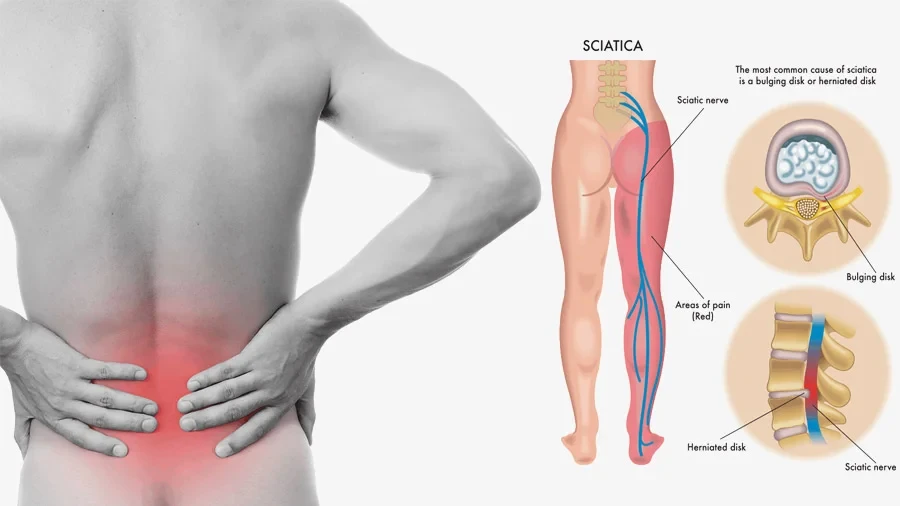Sedentary lifestyles in the modern era has created several imbalances in the human system. Improper sitting postures, long hours of sitting, jerky movements in sports and travel are the important causes of getting a low back pain. Among the various diseases associated with low back pain, Sciatica is one of them, characterized by radiating leg pain and related disabilities. This article is about the treatment of sciatica in Ayurvedic way.
Sciatica resembles the disease Gridharsi of Ayurveda. Gridharsi is one among the Vataja nanatmaja vyadhi, where dysfunction of Vata affect gridharsi nadi characterized by low back pain radiating to lower limbs, stiffness and pricking type of pain. It starts from kati- prishta (pelvic region and Lumbosacral) radiating to jangha paada (Thigh, Feets) with impairment of lifting the leg. The gait of the person is very similar to vulture (Gridhra) hence the name is given as Gridharsi.
Symptoms of Sciatica
The symptoms of sciatica include:
- Moderate to severe pain in lower back, buttock and leg.
- Numbness or weakness in lower back, buttock, leg or feet.
- Pain that worsens with movement; loss of movement.
- “Pins and needles” feeling in legs, toes or feet.
Treatment of Sciatica in Ayurveda
Avoidance of causative factors is the first and foremost principle to be adopted in the treatment. Secondly, dosha vitiation should be considered before deciding the line of treatment. If the Dosha vitiation is minimum Langhana therapy is enough, if the intensity of Dosha vitiation is moderate then Langhana and Pachana treatment should be given. If, Doshas are in Prakopa stage, Shodhana treatment should be decided.
Sodhana (Purificatory Treatment) in Ayurveda
1. Snehana
Snehana or oleation therapy can be given externally and internally. In sciatica, external Snehana may be performed in the form of Abhyanga, Pizhichhil, Avagaha, Parisheka etc.
2. Swedana
Shula (pain) and Stambha (stiffness) in the lower extremities are the main symptoms of sciatica and best treated by the Swedana (Sudation) Chikitsa. Swedana also helps in the liquefaction of the Dosha which assists in clearing the Srotas. Among the different forms of Swedana procedures, Pizhicci, Avagaha Sweda, Nadi Sweda, Patrapinda Sweda, Pinda Sweda and Upanaha Sweda may be efficiently performed in treatment of sciatica. For Vatakaphaja Gridhrasi, Baluka Sweda is preferred.
3. Vamana
Medicated vomiting is done as a part of panchakarma procedure.
4. Virechana and Vasti
Virechana: Virechana (medicated purgation) has an important role in treatment of sciatica in Ayurveda. Virechana has its effects distributed to the whole body. Oral administration of Castor Oil along with milk is best for the Virechana purpose. This will help in both balancing vata as well as smooth excretion of faeces.
5. Basti
Basti is very helpful in pacifying Vata and in treatment of sciatica. Acharya Charaka defines Basti as 50% of all treatments in Ayurveda. No other therapy has the capacity to pacify and regulate the force of Vata apart from Basti. Drugs are administered forcefully through rectal route in Basti, which may reach up to Grahaṇi (duodenum), hence absorption may occur in the jejunum.
In Ayurvedic classics, the Acharyas have tried to explain actions of Basti with suitable analogies as follows. As a tree irrigated at its root level attains nourishment for the whole tree, In the same way, Basti drugs given through Guda [Rich of blood vessels, lymphatic & nerves] Nourishes all the limbs & organs of the body.
Any type of Basti can be adopted but, initially one should purify the body by Shodhana Karma to get the desired effect.
Decoction Basti – Erandamuladi decoction and Dashamuladi decoction are the best choices.
Oil Basti – Oil Basti using anti vata oils like Bala Oil, Ksheerabala Oil etc. are beneficial.
Treatment of sciatica have been described various treatment modalities in the management of Gridhrasi since ancient times. These have stood the test of time and even today, are useful in bringing relief to the sufferers of this dreadful disease.
Prevention of causative factors is the first step towards the management, followed by the various Panchakarma therapies mentioned before. Abhyanga and Swedanamay then be used in the initial phase of management with Basti. It can be said that Ayurvedic management of Gridhrasi is a gift to the modern society, which is effective and easy too.
